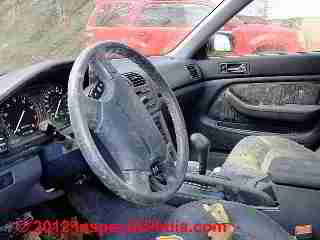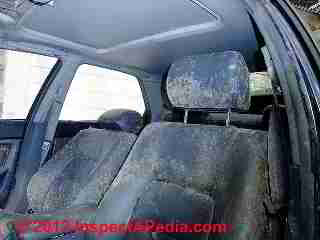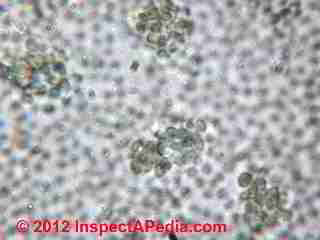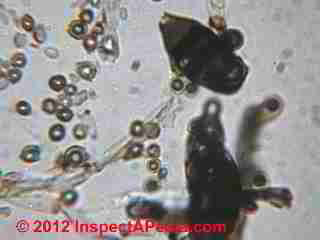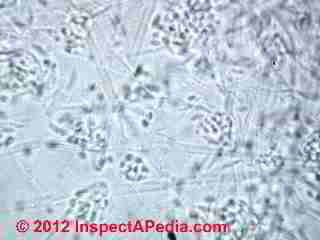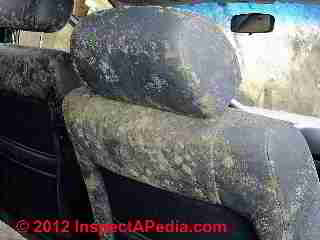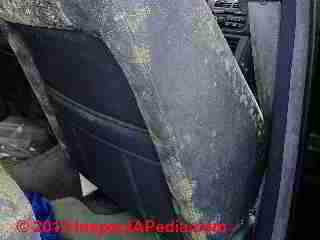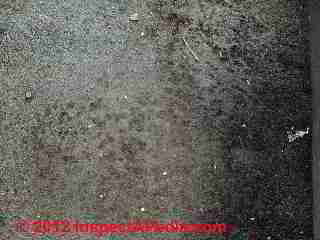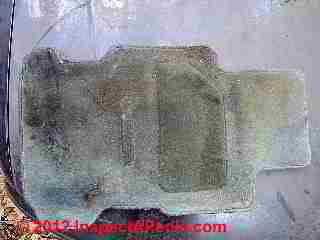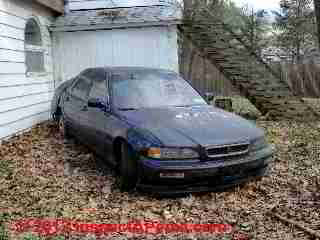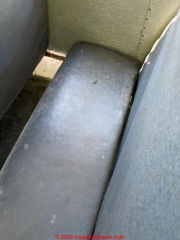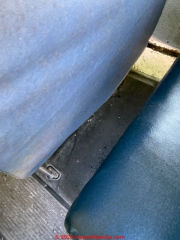 Mold Contaminated Vehicles: Boat, Bus, Car, RV, Truck
Mold Contaminated Vehicles: Boat, Bus, Car, RV, Truck
Severely moldy car analyzed to identify molds; report of illness after cleaning of moldy school buses
- POST a QUESTION or COMMENT about mold contamination found on various surfaces and materials used in automobiles and other vehicles
Aircraft, bus, car, boat, truck or RV mold contamination hazards are discussed here.
This article begins with the description and mold test results for an automobile that was so mold contaminated that it was beyond economical salvage.
To study the types of mold that might be expected to be found on different surfaces and materials used in automobiles and similar vehicles, we inspected the vehicle and collected 30 test samples for processing in our forensic lab. We report here on what lab analysis found in this vehicle.
We also include a report from bus drivers charged with cleaning mold-contaminated school buses during a time that the buses sat idle during the COVID-19 pandemic in 2020-2021. The workers report very serious and ongoing health effects of exposure to mold and possibly due to exposure to cleaning agents used as well.
InspectAPedia tolerates no conflicts of interest. We have no relationship with advertisers, products, or services discussed at this website.
- Daniel Friedman, Publisher/Editor/Author - See WHO ARE WE?
Mold Contamination in Vehicles: Boats, Buses, Cars, RVs, Trucks, Aircraft
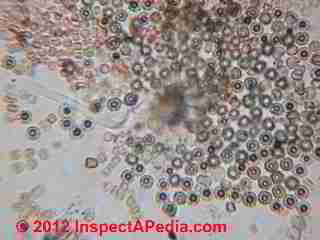 Photographs and Lab Tests of a Very Moldy Car Identify Many Mold Genera/Species
Photographs and Lab Tests of a Very Moldy Car Identify Many Mold Genera/Species
Below we describe the results of collecting and identifying a broad range of molds typically found growing in vehicles left damp or wet and un-attended. You will see that it is common to have extensive areas of toxic or pathogenic molds such as Aspergillus niger and Memnoniella echinata in vehicles along with other allergic or less dangerous molds.
Also see SCHOOL BUS MOLD HAZARDS provided further below.
Daniel Friedman, Steve Lewis[1]
We inspected, photographed, and collected test samples from a severely mold-contaminated 1991 Acura that had been stored for approximately six months in a shady spot in New York's Hudson Valley.
On discovery (March 2012) the car was partially covered with a plastic tarp but was basically exposed to the elements.
Mold of various colors and textures was thick on most, but interestingly not all of the vehicle's interior surfaces and contents.
The interior driver's seat, floor carpets, and trunk interior were wet as were contents of door pockets. Lewis had previously observed droplets of water from leakage or condensation soaking the vehicle headliner as well.
Examining these car-mold samples in our forensic lab, we found that the car had become a veritable jungle of mold multiple mold genera growing on different materials for which each genera appears to have a particular affinity.
Automobile interiors make use of vinyls and plastics of various formulations, rubber, synthetic fabrics, and other materials, forming a nice test lab for examining the affinity of different mold genera/species for different automotive materials. Each mold genera/species confirms by its dominant presence an affinity for certain of these automotive materials.
Some of these molds, found in this vehicle in extensive colonies, are particularly irritating or even harmful to humans, including Acremonium sp., Aspergillus niger, Memnoniella echinata and Penicillium sp.
Mold growth of various colors and textures was found on just about every surface inside the vehicle. But our initial visual inspection (before any lab analysis) suggested by color and texture and general appearance, that several different mold genera/species seemed to be occupying different surfaces and materials in the vehicle.
Some interior surfaces (listed below) had comparatively little or no visible mold growth.
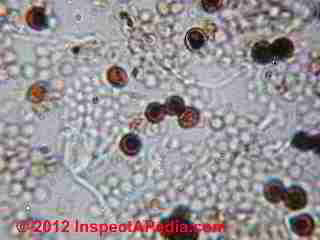
Our lab photo (above left) illustrates the mold genera we found on the steering wheel outer rim (sample #5); at the steering wheel center we found the same fungi but with the addition of Acremonium sp. while the driver's headrest (sample #8) was covered with Trichoderma viride (below).
Before its storage the vehicle had been owned by members of a single family and had been in constant use between 1991 and 2011 - a period of twenty years of reliable service. Prior to storage there were no mold, odor or related complaints about the vehicle.
Mold Growth on Vinyl, Plastic, & Rubber Surfaces in the Automobile
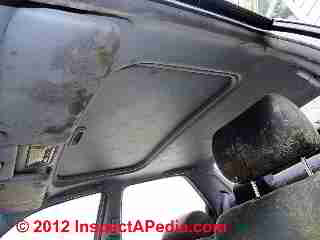 ...
... 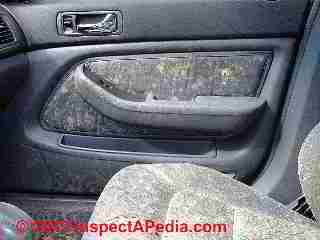
Below we show the two dominant fungal growths on the sun-visor you can see at above-left, Cladosporium sphaerospermum and Ulocladium sp.-like.
And in our next microscope photo below we show our lab results identifying white mold found on the drivers side door liner shown in the photo at above right - sample #2 in our car mold table. The phialids and spore clusters identify this fungus as Acremonium sp.
It was interesting to observe that while mold growth was thick on much of the vinyl covering the passenger seats and door liner center panels, (photo below)
some sections of vinyl in this vehicle resisted mold growth - such as the back panels of the front passenger seats (photo, below).
Moldy Automobile Carpeting
At our examination we saw water tracks in several areas, stains indicating leak points at the sun-roof, driver's side door, and trunk lid.
Our inspection and that of the owner suggested that there were multiple leaks that admitted rain and melting snow into the vehicle both in the passenger space and into the vehicle trunk. Indeed, the driver's seat and carpeting on the driver's side (photo below left) were soaking wet as were objects found stored in the trunk.
 ...
...
Actually we expected to find more visible mold contamination of the floor carpets in this automobile than was visible (photos above).
We don't yet know if the comparatively lower fungal growth (compared to the vinyl surfaces of seats) was due to the chemistry of the carpet, giving it mold resistance, or if it was because of the carpet's very wet condition.
The rubber surface of the car's brake pedal was covered in white mold (photo above left. In the lab we identified this fungus as Acremonium sp.
Moldy Car Contents
It was no surprise that we found heavy mold growth on a range of materials in the automobile's passenger compartment as well as in its trunk, including materials of rubber (boots), paper (currency, maps, etc), and nylon (umbrellas).
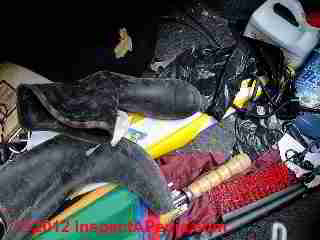
Mold growth identified on moldy dollar bills - U.S. currency mold
As we report in the car mold table below, examining the moldy dollar bills found in this vehicle we identified several dominant mold genera/species: Memnoniella echinata -like spores & conidiophores (photo below left), Chaetomium sp., and what looks like Wallemia serbi.
One other colorless smooth large mold spore was common and remained unidentified.
 ...
... 
Car Components with Little or No Visible Mold Growth
Visible mold contamination was absent or comparatively light on the following interior surfaces of the vehicle:
- Glass surfaces, interior of windows
- Headliner
- Plastic covering instruments in the dashboard
- Radio surfaces
- Vinyl inset panels on the rear of the front seats
- Vinyl panels surrounding the (mold-contaminated vinyl) center panels on the front vehicle doors
- Carpeting (was soaking wet)
- Trunk liner
Table of Car Mold Test Samples Collected & Identification of Mold Genera/Species found in an automobile
Watch out: In our opinion it is generally not cost justified nor appropriate to test a moldy-smelling vehicle to identify which mold genera/species are present - the owner's money is better spent on cleaning and restoring the vehicle. However for academic reasons such as this study we do perform such tests.
Car Mold Contamination Sampling Methodology
The moldy car interior test samples listed in the table were collected using clear adhesive tape unless otherwise stated. A few samples were collected as bulk (a carpet snip and foam seat cushion snip).
Most of the surfaces in the vehicle were man-made materials, primarily plastics or synthetic fiber carpeting or liners but paper and other materials were present. We also sampled a few materials stored-in but not part of the vehicle itself.
Mold test samples might also have been collected using a vacuum cassette approach but as most of the porous car materials such as carpeting and trunk liner were soaking wet we did not consider that a useful approach. We do make use of this approach in studying vehicles that are not wet nor badly contaminated.
For details see CARPET MOLD / ODOR TESTS
A survey might have tested for airborne mold levels in the vehicle but as the vehicle was open to the outdoors (confounding the sample) and as there were readily-available surface samples we did not consider air sampling as a useful step.
See ACCURACY OF AIR TESTS for MOLD for our reservations about air sampling to characterize indoor or enclosed environments.
Table of Car Mold Contamination Test Sample Results |
||
| Sample ID | Location | Lab Results |
| 1 | Driver's door liner - black mold | [in process] |
| 2 | Driver's door liner - white mold | Acremonium sp. fungal spores & phialids in dense colonization |
| 3 | Dashboard left side (abuts door when door is shut) | Cladosporium sp.; tentatively, C sphaerospermum |
| 4 | Driver side door rubber gasket (foam rubber-like) | Acremonium sp. fungal spores and hyphae |
| 5 | Steering wheel outer surface | Cladosporium sphaerospermum |
| 6 | Steering wheel center | Penicillium sp. - dominant |
| 7 | Brake pedal upper surface (rubber) | Acremonium sp. fungal spores and hyphae, almost exclusive |
| 8 | Driver seat headrest | Penicillium sp. - dominant |
| 9 | Driver door window bottom edge interior horizontal gasket (rubber) | Acremonium sp. fungal spores and hyphae, |
| 10 | Driver seat cushion, exposed foam (wet - tape sample) | unidentified mitospores, C. sphaeropsermum-like, along with fabric fibers |
| 11 | Driver seat cushion, exposed foam (wet - bulk sample, foam snip) | analysis held |
| 12 | Handbrake handle (plastic) | Acremonium-like |
| 13 | Driver head-rest side (different colony from #8) | Penicillium sp., dominant Acremonium-like, present Cladosporium sp; - incidental Cladosporium sphaerospermum - incidental |
| 14 | Auto registration sticker (paper) | Cladosporium sp. / C. sphaerospermum |
| 15 | Driver seat belt (nylon) | Penicillium sp. spores, conidiophores; - dominant |
| 16 | Auto contents: U.S. currency, $1. bills, visibly moldy, from center console (bulk sample) |
analysis held |
| 17 | Auto contents: U.S. currency, $1. bills, visibly moldy, from center console (tape sample) |
Memnoniella echinata-like |
| 18 | Driver seat side (vinyl) | Aspergillus niger spores & conidiophores in dense colonization |
| 19 | Rear seat surface, olive-colored mold | Aspergillus sp. spores & conidiophores in dense colonization |
| 20 | Rear seat surface, green + white mold | Penicillium sp. spores & conidiophores; dominant |
| 21 | Auto contents: blue umbrella, black mold-suspect specks | Aspergillus niger - in dense colonization Aspergillus sp; present |
| 22 | Headliner over driver's seat (plastic-like material) | Cladosporium sphaerospermum |
| 23 | Sun roof gasket (rubber/vinyl) | Non-fungal material including insect fragments Pithomyces chartarum - present Cladosporium sphaerospermum - present |
| 24 | Floor mat (carpet, synthetic, wet) | analysis held |
| 25 | Floor mat (carpet, synthetic, wet) (Bulk sample) | analysis held |
| 26 | Trunk liner, rigid synthetic fabric | Aspergillus sp., in dense colonization, spores & conidiophores Cladosporium sphaerospermum - present |
| 27 | Door, rear passenger, center liner (soft vinyl) | Cladosporium sp; C. cladoporioides-like; |
| 28 | Door, rear passenger, center liner (soft vinyl) | Cladosporium sp. |
| 29 | Door, rear passenger, center liner (soft vinyl) | Pen/Asp spores, spore chains, fungal hyphae; (no conidiophores) |
| 30 | Sun visor, driver's side (vinyl) | Ulocladium sp. -like Cladosporium sphaerospermum |
Notes to the table above
[1] lab analysis was completed on 6/30/2012; all samples processed were photo-documented under the microscope, with selections appearing in this report.
Watch out: among the mold genera/species often found growing on or in vehicle interiors, Penicillium and Aspergillus species are particularly dangerous. While the particular Penicillium or Aspergillus species might be any of quite a few different molds in those genera, none of them would be considered harmless.
...
Reader Comments, Questions & Answers About The Article Above
Below you will find questions and answers previously posted on this page at its page bottom reader comment box.
Reader Q&A - also see RECOMMENDED ARTICLES & FAQs
On 2023-02-03 by Cindy - Workers seriously ill after exposure to moldy school buses
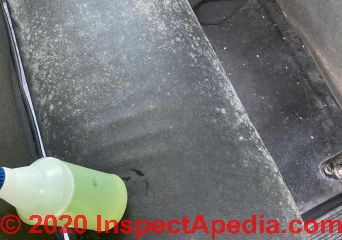 @Carli, it’s been quite a while since March and I just saw your post. I sincerely hope you are well and did not clean that mold!
@Carli, it’s been quite a while since March and I just saw your post. I sincerely hope you are well and did not clean that mold!
Please heed the response and warnings of what happened to us. I’d much rather have given up my job than to be dealing with what I am now and I can say Janet feels the same way.
On 2022-03-21 by Inspectapedia Com Moderator - school bus drivers told to clean moldy school buses without proper training nor protective personal equipment
@Carli,
I hope that you will read with care the long ongoing conversation we have had with other school bus drivers who were told to clean moldy school buses and not given proper training nor protective personal equipment.
You will see that serious illnesses were the result and possibly permanent incapacitation.
Therefore you should approach this topic with great caution and you should be sure that both workers and your management are informed that there may be serious health hazards for both workers and passengers.
You will also read in this case our disappointment that OSHA, the US government agency charged with protecting workers, quite absurdly claimed that they had no jurisdiction or interest in the case.
I should explain also that if mold contamination has infected thick porous materials such as headliners, upholstery, and in some cases seating or seat cushions and padding, those thick materials cannot be successfully cleaned of mold and instead of the entire item needs to be removed and the remaining shell of the vehicle cleaned before the removed items are replaced.
Please do keep us informed and provide photographs and other documentation of what's happening in your case. You can post photos of school bus conditions here but to send us documents you would need to use the page top or bottom contact link.
On 2022-03-21 by Carli
Hello, I been driving a school bus for a while and after Covid the bus is cover with mold. They had us clean the buses as well but the mold came back fast. Now I have tons of health issues I never had before. We can go on strike because of contract. Any contacts of who can help?
Thank you
On 2023-02-03 by InspectApedia Publisher
@Cindy,
Thank you for following-up.
We have at least the faint hope that allowing the sunlight of accurate and public exposure of the hazards of requiring untrained and unprotected workers to clean dangerously moldy school buses will ultimately influence bus authorities.
It would be helpful to provide or make available any expert, un-biased statements or diagnostic reports, for example, from a lab or from your doctor, to help people sort-out and thus to better appreciate these health risks for workers.
Daniel
On 2023-02-03 by Cindy
@Inspectapedia Com Moderator, haven’t updated in a while. Our lives still revolve around specialists several times a month.
I had to resign my position last Monday to go on long term disability with NC retirement system. One of the most difficult things I’ve had to do, cried like a baby. 30 years gone. I have known for a couple of years that I’d never be safe to drive a bus again but hearing the doctor say it and resigning are two different things!
So, Janet has psoriatic arthritis, going blind, ulcerative colitis, and fluid filled cysts on her spine . I have axial spondylarthritis that is leaning towards psoriatic arthritis, I have a neurological condition where one part of my brain no longer communicates with the other, and both of us have neuropathy in hands and feet.
These are in addition to cognitive and memory issues. Our eyes and brains don’t quite work together anymore, what our eyes see and brain sees may be different. Example, I opened a door and the garbage bag in the van billowed out a little and I screamed thinking it was a dog jumping at me, lol no dog.
Still fighting for workers comp over two years later. Our quality of life is pretty poor with constant pain etc but we still have our sense of humor about it.
hopefully by the end of the month we can update that our workers comp has a conclusion and we can get on with less stress from that
On 2021-04-02 by (mod) - Mold-Contaminated North Carolina School Buses Leave Workers Disabled, Extremely Ill & Risk Health of Passengers
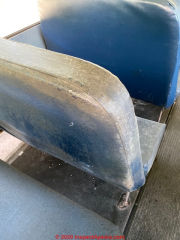 2022-01-18 Moderator reply (to Cindy - below)
2022-01-18 Moderator reply (to Cindy - below)
I am reminded to add how disappointing it was that you and I both contacted OSHA, the federal agency whose job it is to protect workers such as yourselves and got no help.
OSHA replied in a completely ridiculous interpretation that because they viewed school buses as not a "workplace" they would not get involved in your case.
Your reply to that was
What are you talking about?
We are bus drivers, buses are the only place we work.
On 2022-01-08 by Cindy (school bus driver, one of two, told to clean very moldy buses, no protective gear, no training in hazardous mold cleanup)
I try to update every once in a while just in case anyone is interested, and as a warning to others not to walk in our shoes.
After finding 5 new, large nodules in my lungs, for a total of 9 along with new scarring the pulmonologist decided a bronchoscopy with lavage was the next step.
That was done the day before thanksgiving of 2021 and on 01/05/2022 got the results of a non tuberculosis mycobacteria infection. On 01/07/2022 it was reported that they have found the exact species of bacteria and it’s (opposite of resistance, word loss rearing it’s ugly head).
Looks like an ugly couple of years of multiple antibiotics with severe side effects and potential serious toxicities. If that doesn’t work I may lose a lung. Was diagnosed, officially, with fibromyalgia, raynauds syndrome, and Sjögren’s syndrome on 12/06/2021.
We have new lawyers that are really stepping up and moving forward with our case.
To anyone that thinks they can tackle a significant mold project, don’t. It’s not just the mold but the bacteria growing alongside it.
We lost our careers, our independence (we both walk with a cane now), our health.
If it’s large amounts of mold at home just get out, leave it to a professional. If it’s at work, walk away. It’s not worth it.
We know because we couldn’t afford to not work either and now here we are, applying for social security disability and living with disabling pain and infections.
On 2021-11-04 by Cindy - Two feet of intestine removed due to the mold, lost gallbladders, autoimmune disease, neurocognitive disorders & pain, unable to walk, other illnesses from exposure to toxic mold
[Re-posted by moderator rom private email]
Yes we still have our sense of humor most days hence the name moldy drivers.
Well it’s been a year and a couple of months since our beginning exposure to the mold and chemicals. If only I could go back in time and run hard and fast!
So Janet had two feet of her intestine removed due to the mold. As you know we both lost our gallbladders.
I had to have nasal surgery because I can’t use the nasal sprays any longer, they have quats in them.
We’ve been diagnosed with RA, MCTD, and Janet has her special liver autoimmune disease that fortunately I missed out on.
We were sent to the Mars Memory Clinic for cognitive testing a few months ago, what a fight to finally get someone to believe there might be a problem!
The bad news is we have unspecified neurocognitive disorder that they believe is caused by the chemical mold exposure . Didn’t have those issues before.
Good news is that even though we test at a level of full blown dementia, it isn’t dementia and not expected to progress to dementia. The other good news is that I scored three points higher than Janet so she’s still nuttier than I am lol.
Unfortunately, we go to bed in pain and wake up in pain and have pain all the hours in between.
Some days I have to use a cane or crutches. My asthma Is far worse than it’s ever been. I take meds to be at a level above comatose for a few hours a day and at night we fight to get a few hours sleep.
Workers comp mediation was a joke at best and after one more try it’s headed to hearing. Not expecting it to go well because we don’t have proof that mold or chemicals caused our health issues.
Back in august a paper was published that is starting to show just what massive amounts of quaternary ammoniums exposure can do to humans at a cellular level and linked to autoimmune issues.
Sure wish we had gotten in to a toxicologist a year ago to see the levels of chemicals in our bodies! Not to mention the levels of mold.
Anyway, hope you’re doing well!
I hope I’m a month or so there’s been a miracle and I can come on here and say we won our case .
I’ve been told I’ll never drive a bus again much less any other type of work so to say I’m worried financially is an understatement so fingers crossed that workers comp works out!
Have a great day, stay out of mold, be safe around chemicals
On 2021-07-12 by danjoefriedman (mod)
@emilyrose4876,
Thanks those added details may help other readers.
On 2021-07-12 by emilyrose4876 - no tests done on moldy school buses, "cleaned" with Incide V.5, Mold Armor without bleach, numerous leaks
@danjoefriedman,
I’m sorry to reply so late. My short term memory reads its ugly jess and I forget I updated here. (or maybe I did respond and don’t remember)
There was never any testing , besides our botched attempt, on the mold.
The chemicals were incide v.5 and mold armour Without bleach . The windows on some were partially open, hatches leak, doors leak, sitting in wet fields.
On 2021-04-02 by (mod)
Cindy & Janet:
I've added your update to the article above at
inspectapedia.com/mold/Car_Mold_Catastrophe.php#SchoolbusMold MOLDY SCHOOL BUS HAZARDS in North Carolina
As I noted earlier, if/when it's easy for you or an associate, It would be helpful to add photos of the fleet of parked school buses in the lot and of an individual bus from its exterior;
It would also be helpful to document whether or not any tests were performed of the mold contamination - of which in my view surface tape samples of mold by color and location and material on which it was found are useful, even though different additional mold genera will often be found inside different, less-accessible areas such as vehicle insulation, carpet padding, backs of floor or firewall liners, headliners, seat cushion material, painted surfaces.
Knowing the specific brand of Quat cleaners used will be important to add to the documentation as well a description of how they were applied. The brand and product ID would permit us or others to find the product specific MSDS and other information provided by the manufacturer.
How many mold-contaminated school buses did you and Janet see, enter, try to clean?
Did anyone describe the probable cause of mold growth of these parked buses: windows open, water leaks, or simply being shut-up and parked, disused, during the period of the COVID-19 pandemic when the buses naturally fell out of use?
On 2021-04-02 by (mod) - Mold-Contaminated North Carolina School Buses Leave Workers Seriously Ill and Risk Health of Riders
 @Cindy,
@Cindy,
Thank you for that important, if painful, update.
It has been difficult for many people exposed to environmental hazards to be sure that their doctor has the best expertise to diagnose and treat them; often asking your primary doc to help find an expert is the best approach.
Also at MOLD DOCTORS - ENVIRONMENTAL MEDICINE we give ways to find physicians who specialize in that concern.
I trust your doctors and lawyer keep in mind that you are describing probable exposure to high levels of molds that are known to be a health hazard as well as exposure to cleaners that might be a health hazard, are at least a respiratory irritant, and that might interact with mold exposure to produce still more-serious health issues.
For other readers, a quick Google Scholar search for research on "Quaternary ammonium biocide health hazards" finds about fifteen thousand articles related to that question. In sum there is already a large body of research on these cleaning agents.
At least some research points to a concern (where people are exposed to Quats) for pathogens that develop immunity (Hegstad 2010) (Soumet 2016) while other research asserts hazards similar to exposure irritating/corrosive chemicals (Luz 2020). Yet these compounds also have medical application such as preventing biofilm growth on esophageal prostheses (Oosterhof 2006) and a quick scan of search results finds more articles lauding the antimicrobial properties of these compounds than those citing health hazards.
Some often-cited examples of research on the usefulness of and medical properties of Quaternary ammonium biocides include:
- DeLeo, Paul C., Carolyn Huynh, Mala Pattanayek, Katherine Clark Schmid, and Nathan Pechacek. "Assessment of ecological hazards and environmental fate of disinfectant quaternary ammonium compounds." Ecotoxicology and environmental safety 206 (2020): 111116.
Highlights
• Robust databases exist for environmental toxicity and fate of ADBAC and DDAC.
• Ecotoxicity of ADBAC and DDAC is greater than that for other surface active agents.
• ADBAC/DDAC are removed during wastewater treatment by biodegradation and sorption.
• The ecotoxicity of DDAC and ADBAC is mitigated by environmental fate characteristics.
Abstract
Disinfectant quaternary ammonium compounds (Quats) have diverse uses in a variety of consumer and commercial products, particularly cleaning products.
With the emergence of the COVID-19 pandemic, they have become a primary tool to inactivate the SARS-CoV-2 virus on surfaces. Disinfectant Quats have very low vapor pressure, and following the use phase of the products in which they are found, disposal is typically “down-the-drain” to wastewater treatment systems. Consequently, the potential for the greatest environmental effect is to the aquatic environment, from treated effluent, and potentially to soils, which might be amended with wastewater biosolids.
Among the earliest used and still common disinfectant Quats are the alkyl dimethyl benzyl ammonium chloride (ADBAC) compounds and the dialkyl dimethyl ammonium chloride (DDAC) compounds. They are cationic surfactants often found in consumer and commercial surface cleaners. Because of their biocidal properties, disinfectant Quats are heavily regulated for human and environmental safety around the world.
Consequently, there is a robust database of information regarding the ecological hazards and environmental fate of ADBAC and DDAC; however, some of the data presented are from unpublished studies that have been submitted to and reviewed by regulatory agencies (i.e., EPA and European Chemicals Agency) to support antimicrobial product registration.
We summarize the available environmental fate data and the acute and chronic aquatic ecotoxicity data for freshwater species, including algae, invertebrates, fish, and plants using peer-reviewed literature and unpublished data submitted to and summarized by regulatory agencies.
The lower limit of the range of the ecotoxicity data for disinfectant Quats tends to be lower than that for other surface active agents, such as nonionic or anionic surfactants.
However, ecotoxicity is mitigated by environmental fate characteristics, the data for which we also summarize, including high biodegradability and a strong tendency to sorb to wastewater biosolids, sediment, and soil. |
As a result, disinfectant Quats are largely removed during wastewater treatment, and those residues discharged in treated effluent are likely to rapidly bind to suspended solids or sediments, thus mitigating their toxicity. - Hegstad, Kristin, Solveig Langsrud, Bjørn Tore Lunestad, Anne Aamdal Scheie, Marianne Sunde, and Siamak P. Yazdankhah. "Does the wide use of quaternary ammonium compounds enhance the selection and spread of antimicrobial resistance and thus threaten our health?." Microbial drug resistance 16, no. 2 (2010): 91-104.
Abstract
Quaternary ammonium compounds (QACs) are widely used biocides that possess antimicrobial effect against a broad range of microorganisms. These compounds are used for numerous industrial purposes, water treatment, antifungal treatment in horticulture, as well as in pharmaceutical and everyday consumer products as preserving agents, foam boosters, and detergents.
Resistance toward QACs is widespread among a diverse range of microorganisms and is facilitated by several mechanisms such as modifications in the membrane composition, expression of stress response and repair systems, or expression of efflux pump genes.
Development of resistance in both pathogenic and nonpathogenic bacteria has been related to application in human medicine and the food industry. QACs in cosmetic products will inevitably come into intimate contact with the skin or mucosal linings in the mouth and thus are likely to add to the selection pressure toward more QAC-resistant microorganisms among the skin or mouth flora. There is increasing evidence of coresistance and cross-resistance between QACs and a range of other clinically important antibiotics and disinfectants.
Use of QACs may have driven the fixation and spread of certain resistance cassette collectors (class 1 integrons), currently responsible for a major part of antimicrobial resistance in gram-negative bacteria.
More indiscriminate use of QACs such as in cosmetic products may drive the selection of further new genetic elements that will aid in the persistence and spread of antimicrobial resistance and thus in limiting our treatment options for microbial infections. - Luz, Anthony, Paul DeLeo, Nathan Pechacek, and Mike Freemantle. "Human health hazard assessment of quaternary ammonium compounds: Didecyl dimethyl ammonium chloride and alkyl (C12–C16) dimethyl benzyl ammonium chloride." Regulatory Toxicology and Pharmacology (2020): 104717.
- McBain, Andrew J., Ruth G. Ledder, Louise E. Moore, Carl E. Catrenich, and Peter Gilbert. "Effects of quaternary-ammonium-based formulations on bacterial community dynamics and antimicrobial susceptibility." Applied and environmental microbiology 70, no. 6 (2004): 3449-3456.
- Oosterhof, Janine JH, Kevin JDA Buijssen, Henk J. Busscher, Bernard FAM van der Laan, and Henny C. van der Mei. "Effects of quaternary ammonium silane coatings on mixed fungal and bacterial biofilms on tracheoesophageal shunt prostheses." Applied and Environmental Microbiology 72, no. 5 (2006): 3673-3677.
- Soumet, Christophe, Delphine Méheust, Christine Pissavin, Patricia Le Grandois, B. Frémaux, Carole Feurer, A. Le Roux, M. Denis, and Pierre Maris. "Reduced susceptibilities to biocides and resistance to antibiotics in food‐associated bacteria following exposure to quaternary ammonium compounds." Journal of applied microbiology 121, no. 5 (2016): 1275-1281.
On 2021-04-02 by Cindy - It took 5 months to find a doctor that realized we were also chemically poisoned
Hi Daniel,
I’m not sure if your questions after your response are from the same date so I’ll answer just in case.
Janet and I cleaned approximately 70 buses using In-cide v.5 and mold armpit without bleach, basically the same ingredients. They are made up of multiple quaternary ammoniums and are know. To cross the blood brain barrier.
We have had to learn how to cope with the short term memory loss and try to laugh through the hiccups it causes . The unreal joint pain is another story, can’t laugh at that! Finding doctors to treat us has been incredibly difficult, especially the neurology part.
It took 5 months to find a doctor that realized we were also chemically poisoned and of course by then there’s no evidence that we had chemicals in our bodies, just the effects it had on our bodies. My latest test on Tuesday shows that my liver lesions have doubled in size also but don’t know what it means for me.
We have a lawyer and he’s doing all he can for us. It’s very difficult finding anyone that has the proper credentials to say “yes mold can do more than lung damage”. Quaternary ammoniums are just recently really being studied for their harmful effects on humans however, any chemical that is being used in the amounts we were using in an enclosed space without good ventilation is dangerous.
On 2021-03-31 by (mod)
@Cindy, It would be helpful to add photos of the fleet of parked school buses in the lot and of an individual bus from its exterior;
It would also be helpful to document whether or not any tests were performed of the mold contamination - of which in my view surface tape samples of mold by color and location and material on which it was found are useful, even though different additional mold genera will often be found inside different, less-accessible areas such as vehicle insulation, carpet padding, backs of floor or firewall liners, headliners, seat cushion material, painted surfaces.
Knowing the brand and product of specific cleaners and fungicides used will be important to add to the documentation as well a description of how they were applied.
How many mold-contaminated school buses did you and Janet see, enter, try to clean?
Did anyone describe the probable cause of mold growth of these parked buses: windows open, water leaks, or simply being shut-up and parked, disused, during the period of the COVID-19 pandemic when the buses naturally fell out of use?
I have passed on this case, again, to the New York Times but heard no reply from that newspaper.
On 2021-03-31 by Cindy - I have an obstructive lung disease now and some very serious heart damage. We have tens of thousands of dollars in medical bills.
This is just a quick update from the bus cleaning.
Janet and I are out on short term disability.
Our neurological issues have not resolved....short term memory loss, word finding loss, cognitive dysfunction. Tumors in lungs, and liver. Gastrointestinal issues. We both lost our gallbladders. Janet has two autoimmune diseases attributed to the molds and the chemicals we were using, both diseases attack the liver, one has no known treatment. She also has a tumor on her spine now.
I have an obstructive lung disease now and some very serious heart damage. We have tens of thousands of dollars in medical bills.
We’ve been told our lives will be shortened greatly from our exposure.
By the way, fungicides are considered pesticides by the epa and we used five gallons a day inside buses with no ventilation, had we only known....
Mold and chemicals are no joke. Be wise and get professional help to take care of it.
On 2021-03-31 by Cindy - update from the bus cleaning workers: mold contamination leaves workers with serious, long-term health injuries
This is just a quick update from the bus cleaning.
Janet and I are out on short term disability.
Our neurological issues have not resolved....short term memory loss, word finding loss, cognitive dysfunction. Tumors in lungs, and liver. Gastrointestinal issues
. We both lost our gallbladders.
Janet has two autoimmune diseases attributed to the molds and the chemicals we were using, both diseases attack the liver, one has no known treatment. She also has a tumor on her spine now.
I have an obstructive lung disease now and some very serious heart damage.
We have tens of thousands of dollars in medical bills. We’ve been told our lives will be shortened greatly from our exposure.
By the way, fungicides are considered pesticides by the epa and we used five gallons a day inside buses with no ventilation, had we only known....
Mold and chemicals are no joke. Be wise and get professional help to take care of it.
Moderator reply: disturbing news about moldy school buses in North Carolina
@Cindy,
Thank you for this important, and of course very disturbing update on the moldy school bus clean-up problem that we have been discussing for a long time now. We can but hope that you are getting proper medical attention.
Do you and Janet have an attorney who is assisting you and who might find better success at convincing your school bus management that very serious health and safety concerns are present in school buses that are badly mold-contaminated?
Summing up improper school bus mold cleanup hazards for other readers:
Two school bus drivers were told to clean up school buses that were badly contaminated by harmful mold; the drivers were not given training in proper mold remediation, not given proper protective equipment, not trained in personal safety, and from their description, no proper mold cleanup was being performed, thus putting not only the two drivers at risk but also risking the health of children who would, in the future, be transported in these buses.
We found that OSHA, at least while under the Trump administration, considered the case outside its jurisdiction, telling the workers that a school bus was not a place of employment.
My own notification in writing to OSHA went without response.
My suggestion to the New York Times, in an email to Resnick, went un-answered: no surprise as the Times is doubtless always deluged with un-solicited mail and article suggestions.
My suggestion to the workers was to concentrate first on their own personal health and safety and to follow advice from their doctors.
But it’s too easy for a remote observer to make suggestions that are far less easy to follow by people who depend on their job to be able to buy food or pay rent. The workers continued to attempt to clean the school buses, and both have, as you can read above, suffered very serious consequences.
My suggestion to notify school bus management both orally and in writing of these hazards was to no avail.
We can but hope that other readers, both workers and workplace managers, faced by similar unsafe and mold-contaminated vehicles or other workplaces will find this case a warning and might better protect themselves.
- Opinion of Daniel Friedman, Editor.
It would be helpful to add photos of the fleet of parked school buses in the lot and of an individual bus from its exterior;
It would also be helpful to document whether or not any tests were performed of the mold contamination - of which in my view surface tape samples of mold by color and location and material on which it was found are useful, even though different additional mold genera will often be found inside different, less-accessible areas such as vehicle insulation, carpet padding, backs of floor or firewall liners, headliners, seat cushion material, painted surfaces.
Knowing the brand and product of specific cleaners and fungicides used will be important to add to the documentation as well a description of how they were applied.
How many mold-contaminated school buses did you and Janet see, enter, try to clean?
Did anyone describe the probable cause of mold growth of these parked buses: windows open, water leaks, or simply being shut-up and parked, disused, during the period of the COVID-19 pandemic when the buses naturally fell out of use?
I have also passed on this case, again by email, to the New York Times.
Question: Hazards of severe mold contamination of school bus seats in 200 North Carolina buses (NC coastal area)
Wondering if you can possibly determine what mold this may be so I’ll know what I’m being exposed to. Two of us are cleaning 200 buses that look like the photo I’m adding.
All seat surfaces look like this. The seats should be a bright blue. We are in southeast coastal North Carolina.
Moderator reply: visually obvious mold contamination in school buses
That certainly looks like mold, though I can't say for sure what genera/species from just a photo;
from having identified molds growing on vehicle upholstery before, it's possible that it's a species of Aspergillus that can cause serious health problems, particularly if you are exposed to high levels or over a long period (days, weeks, or more);
Watch out: Aspergillus as well as some other molds can cause respiratory illness and possibly other fungal infections such as of the eye or in cuts.
Don't panic - that's bad for your health, too.
But do insist on wearing appropriate personal protective equipment: eye protection, gloves, respiratory protection: a respirator with HEPA and VOC filtration, and if I were working in such an environment, on arriving home I'd put my clothes right into the washing machine.
Just spraying a "cleaner" as well as trying to "kill" mold with bleach are ineffective and dangerous. The mold needs to be physically removed from the surfaces and the cause of its growth (*perhaps leaks or buses that got wet and were left closed up) fixed.
It's also possible that there is more mold contamination such as within the padding of the seats or in any carpets or other soft materials in the buses.
Where is this work being done? Country & City?
Are you employed such that OSHA work rules pertain? If so you might need help from OSHA.
Just to be clear, there's never going to be just one mold general or a species present. There will be multiple there. Some are more hazardous than others. OSHA's contact number for workers issues:
Contact OSHA: 1 (800) 321-6742
For simple and inexpensive surface mold contamination sample collection for testing
see TAPE & BULK SAMPLING & TESTS for MOLD
Reader follow-up: our doctors told us not to go near these school buses; our managers told us to clean them; we begged for personal protective equipment!
Yes I’ve been educating myself on mold the last couple of weeks and after reading your article, which was extremely informative, helped me understand how many different molds I’m possibly dealing with.
Thank you for the OSHA contact information!
I’ve been documenting with pictures what we are being exposed to and tomorrow I’m going to use tape to get a few samples for just in case.
Get it on tape and seal in a plastic bag.
...
We took multiple samples of molds from the buses using tape, so glad we did that! We discovered the mold is in the heater vents on the floor, a/c vents (if the have ac), on the steering wheel, floor, and on the bottom of the seats where we can’t reach to clean.
We tried using safety glasses and goggles that I bought but they fogged up and we couldn’t see.
Janet used worker’s compensation today to go have her eyes checked, I just took myself to the eye dr.
Her dr told her she can’t go near the buses to clean or drive them. My eye dr told me it was a severe reaction to the mold and it was also making my eyelashes fall out. She was pulling them out from under my eyeballs.
Janet's dr is sending her to a specialist and we e been told repeated exposure to our eyes could lead to blindness.
Our eyes feel like we have sand in them, they itch, burn, swell, and turn blood red.
So now she’s out of a job and I’m trying to decide my next move.
We started talking tonight after I asked her if she was having stomach issues.
Sure enough, severe belly pain and upset stomach, extreme fatigue, every joint in our bodies hurt, have random small red dots on our extremities, headaches, nasal congestion, cough, burning sore throat, post nasal drip, and the list just keeps going it seems.
We’ve shown the director the issue and we’ve begged for PPE [Personal Protective Equipment -Ed] and help to no avail.
We’ve been told to go slow and don’t worry about it, they know all the buses won’t be cleaned and some will be running with mold on them.
We’ve been very explicit about how dangerous it would be to put drivers and children on the buses like that but they don’t seem to care or understand.
We contacted OSHA and they don’t consider a school bus a place of employment so they won’t help.
Now it looks like we are going to have to contact lawyers because despite our use of the masks they provided and the gloves we bought we may have long term health problems now.
Moderator OPINION:
I would call OSHA again for help, realizing that the current government administration is not necessarily supportive of workers.
Explain that your employer is requiring you to clean the buses so they are absolutely a place of employment. That is also the case for bus drivers.
Simply refer to the U.S. Bureau of Labor Statistics: https://www.bls.gov/oes/2018/may/oes533022.htm
Excerpt:
Occupational Employment and Wages, May 2018
53-3022 Bus Drivers, School or Special Client
Transport students or special clients, such as the elderly or persons with disabilities. Ensure adherence to safety rules. May assist passengers in boarding or exiting.
Watch out: given that you have already had serious medical consequences and are warned by your doctors it is evident that you need to stay out of those buses entirely.
It sounds as if you're getting very important advice from your doctors and you need to follow it.
It's worth noting to the bus owners or management that not only are those unsafe - hazardous to you as workers being told to clean them, but they will be unsafe to transport people as well particularly because of the difficulty or possibility of adequate removal of the mold contamination.
An asthmatic, elderly person or infant put into the environment of one of those buses could become extremely ill very quickly.
Reader follow-up: North Carolina Department of Transportation ignores unsafe school buses
The transportation Dept knows about the issues but still maintain buses will run as is. I’m asthmatic and have mold allergies. One other driver is asthmatic and has copd cleaning this crap as well.
Latest comment from coordinator was “molds are funny things”. Warning about kids and driver health is falling on deaf ears. Now one driver has lost her job due to worker’s compensation dr putting off all buses even when school starts back.
Think I’m going to be next
Moderator Reply: seriously-mold-contaminated school buses put drivers and school children at risk
Anecdotal evidence as well as ample expert, peer-reviewed research on mold related illness tell us not to ignore mold contamination such as your photos show in the buses we've discussed. Management who ignore this information do so at not only their own peril but at that of the people who operate, ride, clean or service vehicles that are badly contaminated with mold.
Extensive testing has confirmed that among the most-common mold contaminants on vehicle upholstery and plastics as well as some other surfaces include highly toxic and dangerous species of Aspergillus, Penicillium, and other fungi.
And you've noted that some moldy areas in these buses cannot be immediately or easily accessed for cleaning.
It is also my experience that when porous materials such as seat cushioning or the under-side of plastic-coated fabrics or insulation are mold-contaminated they cannot be effectively cleaned and instead must be replaced.
I have inspected and tested a large number of buildings for mold contamination as well as investigated many cases of mold-related illness.
I have had two reports of permanent blindness in two workers (electricians) each of whom got moldy debris in an eye.
I have investigated a case of an audiologist whose soundproof testing booth was mold contaminated: everyone working in the office knew about the mold but no one was particularly allergic to it so it was ignored. Then a teen-aged client was shut into the booth for testing. They didn't know he was allergic to mold and was asthmatic. He went almost immediately into anaphylactic shock and nearly died.
Watch out: In my OPINION, Management who do not take these warnings seriously, especially given with documentation and in writing, are facing grave liability and may indeed be directly responsible for very serious consequences including serious, even life-threatening health reactions among sensitive people who may enter, work-on or ride in a badly-contaminated vehicle.
You are welcome to pass on our correspondence to the people involved.
In a case where workers are concerned for personal safety and where they are unable to reach agreement with management about how to proceed safely, it is appropriate to ask for help from OSHA where experts can give appropriate advice: 1 (800) 321-6742
On 2020-12-24 - by (mod) - mold in a converted van
Louise
We need to find the cause and fix that.
We need to decide if the mold is really on the exterior of surfaces or if it's inside wall and ceiling or floor cavities;
Finished surfaces (use any household cleaner on hard surfaces, moldy soft goods like carpets that can't be put in the washer can't be cleaned of mold and are tossed out)
So just cleaning and sealing isn't going to be useful without that diagnosis.
I'd pick the worst-looking spot(s) or the most-suspect spots (where a leak into the van cavities is most-suspected) and do some deeper investigating - maybe removing a receptacle cover or other opening, or if necessary cutting a small opening to inspect the cavity.
You can post images using the "add image" button (one per comment) that might let me make more specific suggestions.
Do keep me posted.
On 2020-12-24 by Louise - mold in converted van in the Pacific Northwest
We have discovered mold beginning to take hold in a converted van with woodwork constructed using untreated Baltic birch plywood. The problem begins as dark/discolored patches in parts of the van where things are stacked or enclosed, and thus poor air circulation. Some of these spots are now beginning to blossom with raised white mold.
Since the van is a living space, it's now winter in the Pacific Northwest, and the budget is limited, adequate cleaning, drying and sealing of the surfaces is going to be problematic. Can you make some recommendations?
On 2019-04-02 - by (mod) - "black mold" in vehicles?
Jeff
Recognizing that while there were dark molds in the car, nevertheless the green, tan, brown, yellow, orange and other colors were so abundant and harmflul (mostly species of Aspergillus and Penicillium) that I didn't think there was value attending to the "black mold" despite its popularity in the media.
Thanks for asking:
"Analysis held" means I decided not to examine those samples as it wouldn't change the overall assessment.
On 2019-04-01 by Jeff D.
Was there ever a final outcome of the analysis done on the black mold where it is listed above as "In Process"? & What is the meaning of "analysis held"?
Thanks.
On 2017-01-31 - by (mod) -
John
The answer to car salvageablility depends not on whether or not there is airborne mold inside the vehicle, as that'd be common in most cases. Rather the ability to salvage a car economically depends on the costs involved in two steps:\
1. find and fix the leak(s) that caused the mold growth
2. find and either remove & replace moldy materials or if possible, successfully clean them. It is usually possible to clean hard surfaces and vinyl surfaces but cleaning of moldy upholstered seats or carpeting is not likely to be successful unless the amount of contamination was trivial. So you'd replace moldy carpets, padding, cloth seats, headliners - all of those can add up to a significant cost.
On 2017-01-31 by john ennis
if themold is air born in a car is the car salvagable
On 2017-01-26 - by (mod) -
Misty,
It seems to me from your text that we need to do at least two things.
One is to find the leak or what conditions that are causing mold growth in to fix those.
Two is to find what has actually become mold contaminated.
Pending on what that is it may be possible to clean it. For example curtains, bedding, clothing. Even perhaps seats or hard surfaces in the van interior.
Moldy carpets and padding can be removed.
However if the van has very extensive mold contamination such as the extreme examples of these articles, involving headliner, doors, then
On 2017-01-26 by Misty braden
Me and my husband and dog are living in our van for the moment and we have noticed black mold and i have all most all the symptoms that it causes so how long before i die from this love this is not even cool but we dont have a choice for now dont know what to do
On 2015-10-27 by Anonymous
will car mold kill you
Question / Comment: Everyone should have their vehicle tested for mold ?
A good study overall and confirms my findings as my partner and I have been testing vehicles for several months.
Everyone should have their vehicle tested. New or used and should also google the Tim Greene story about hoe Toxic mold almost took his life. - John Gainey, 5/22/12
Reply: No. we disagree. Testing all vehicles for mold would be inappropriate and wasteful.
Thanks for the comments, John. Indeed a moldy car, because you drive around in a small enclosed space, can significantly affect those who for any reason are sensitive. But it would be improper and unethical to suggest that everyone who owns a vehicle should spend on mold testing for the vehicle, because
- only a small percentages of vehicles have mold contamination
- an "air test" alone would be completely unreliable as a screen for the presence of problematic mold in a vehicle (car, boat, RV, airplane), in particular if negative results are obtained.
- a very moldy car is visibly or often by smell very obviously contaminated - without testing
More useful would be advice that helped people decide when inspection or testing for mold are actually appropriate.
At MOLD ACTION GUIDE - WHAT TO DO ABOUT MOLD readers will see an article
titled MOLD / ENVIRONMENTAL EXPERT, HIRE ? - that pertains to buildings not cars, but might be helpful in illustrating the type of reasoning that an unbiased expert should offer.
Where car mold expertise can be helpful is in tracking down a musty moldy odor whose source is not visibly obvious. Follow the leaks and see what got wet from water, antifreeze, or other similar problems.
Watch out: while ozone treatments are a common "deodorizing" and "mold killing" service offered by car cleanup companies, overdosing a vehicle with ozone is way too easy - the ozone generator is operating inside of a very small space. Too often the result is oxidation of plastics or vinyls in the vehicle that leave it with a horrible chemical smell that is corrected only by gutting the damaged materials.
See OZONE MOLD / ODOR TREATMENT WARNINGS for details.
...
Continue reading at MOLD CLEANUP GUIDE- HOW TO GET RID OF MOLD or select a topic from the closely-related articles below, or see the complete ARTICLE INDEX.
Or see these
Recommended Articles
- CAR MOLD CONTAMINATION What kinds of mold are typically found in a badly mold-contaminated vehicle?
- CAR SMELL & ODOR Diagnosis - separate article
- CAR SMELL - Mold DEODORIZING - separate article
- CARPET MOLD / ODOR TESTS - separate article
- FLOODED CAR DETECTION - separate article
- OZONE MOLD / ODOR TREATMENT WARNINGS - separate article
- SMELL PATCH TEST to FIND ODOR SOURCE.
Suggested citation for this web page
CAR MOLD CONTAMINATION at InspectApedia.com - online encyclopedia of building & environmental inspection, testing, diagnosis, repair, & problem prevention advice.
Or see this
INDEX to RELATED ARTICLES: ARTICLE INDEX to MOLD CONTAMINATION & REMEDIATION
Or use the SEARCH BOX found below to Ask a Question or Search InspectApedia
Ask a Question or Search InspectApedia
Try the search box just below, or if you prefer, post a question or comment in the Comments box below and we will respond promptly.
Search the InspectApedia website
Note: appearance of your Comment below may be delayed: if your comment contains an image, photograph, web link, or text that looks to the software as if it might be a web link, your posting will appear after it has been approved by a moderator. Apologies for the delay.
Only one image can be added per comment but you can post as many comments, and therefore images, as you like.
You will not receive a notification when a response to your question has been posted.
Please bookmark this page to make it easy for you to check back for our response.
IF above you see "Comment Form is loading comments..." then COMMENT BOX - countable.ca / bawkbox.com IS NOT WORKING.
In any case you are welcome to send an email directly to us at InspectApedia.com at editor@inspectApedia.com
We'll reply to you directly. Please help us help you by noting, in your email, the URL of the InspectApedia page where you wanted to comment.
Citations & References
In addition to any citations in the article above, a full list is available on request.
- [1] Stephen Lewis is an architect and computer science teacher who lives and works in New York City.
- [2] "Health effects of a mold-contaminated automobile", J. Santilli, W. Rockwell, W. Vaughn, Journal of Allergy and Clinical Immunology, Volume 113, Issue 2, Page S59. Quoting abstract:
Most reactions to indoor mold exposure have been reported from mold-contaminated homes, office buildings or schools. We report a patient who experienced symptoms from exposure to a contaminated air-conditioner in her automobile.
A patient with a two-year history of generalized symptoms that continued despite taking two months off of work was skin tested and administered the Rhinitis Outcome Questionnaire (ROQ) and Cognitive Questionnaire (CQ) to assess her symptoms. Her indoor environments were also tested for mold contamination. Her home was tested using the Allergenco MK-3 Sampler for which we consider normal indoor counts below 1000 spores/M3. The mold counts in the patient's car were tested using an Anderson Sampler for which we consider normal counts less than 200 CFU/M3.
The patient had positive ID testing to Alternaria, Aspergillus, Penicillium and Cladosporium. The indoor mold counts in her home did not indicate indoor mold growth. The ROQ and CQ both gave similar results, showing low, non-allergic symptom scores before exposure, then moderate to severe symptoms at the height of exposure and a return to baseline upon avoidance of exposure. The result of testing her car with the ventilation system running was high: 1,740 CFU/M3, Penicillium (42%) and Aspergillus (58%). Avoidance of the car brought about a marked improvement in symptoms and she was able to return to work.
This case demonstrates that we should be testing work environments, homes and schools for mold contamination and must now add automobiles to our testing regimen where indicated. - [3] "Mold contamination of automobile air conditioner systems", Kumar P, Lopez M, Fan W, Cambre K, Elston RC., Ann Allergy. 1990 Feb; 64(2 Pt 1):174-7. Department of Medicine, Louisiana State University Medical Center, New Orleans. Abstract:
Eight cars belonging to patients who were found to have exacerbation of allergic rhinitis and bronchial asthma after turning on the air conditioner in their cars were examined. Mold concentrations inside the passenger compartment with the a/c turned off and at different climate control settings were lower than concentrations in the outside air. After turning on the air conditioner to "Max", cultures obtained at various intervals revealed that mold concentrations decreased significantly with time. Furthermore, placement of a filter at the portal of entry of outside air significantly reduced the mold concentration in the passenger compartment. - [4] ASTM E2600 - 08 Standard Practice for Assessment of Vapor Intrusion into Structures on Property Involved in Real Estate Transactions is available from the ASTM at astm.org/Standards/E2600.htm
"This practice is intended for use on a voluntary basis by parties who wish to conduct a VIA on a parcel of real estate, or more specifically conduct a screening evaluation to determine whether or not there is potential for a VIC, and if so, identify alternatives for further investigation."
The standard goes on to emphasize the uncertainty in testing any site for gases and vapor intrusion. - "Shaky Seats, Leaky Fluids, Toyota" Scott Sturgis, The New York Times, 01/24/2010, Automobiles section, p. 4.
- Thanks to B.L., Poughkeepsie, NY, for discussion of the cause and cure of moldy car smells and permission to take and use photos of the family's moldy car during its mold deodorizing procedure, 2009.
- [5] Thanks to M.R. for discussing an ineffective attempt at deodorizing a smelly car - November 2010
- [6] Click and Clack the Tappet Brothers, is the nom-de-radio for NPR's Car Talk radio program hosts Tom and Ray Magliozzi, who can also be contacted by telephone at 888-227-8255.
An online discussion of the detection, cause, and cure of smells or mold in cars, reviewing this InspectAPedia article has been opened at Car Talk at http://action.publicbroadcasting.net/cartalk/posts/list/2136105.page - [7] Carpeting odors: diagnose & cure carpet smells due to mold, mildew, pet urine, and carpet stains - thermal tracking, and carpet testing advice
- [8] Mold Odors and Moldy or Musty Smells: Here are articles on diagnosing moldy or musty building odors
- [9] Ozone Odors & Ozone "deodorizers": The Use of Ozone Generators Indoors for Control of Odors and Mold Removal in Buildings: A Summary of Hazards and False Claims.
Ozone is widely promoted by ozone generating equipment companies and cleaning services for use in indoor building environments to deodorize, disinfect, "kill" mold, and for "general health".
This article explains the effects of using ozone in buildings for these purposes and warns consumers about misapplication of and health risks from ozone in buildings. Because at least some of these claims are based on marketing desire, not good science, and because ozone exposure can be both dangerous and ineffective indoors, we have collected some information and references on this topic. - [10] Ozone generators: The Hazards of Ozone & Ozone Gas Generators. This article gives an overview of the hazards associated with use of ozone indoors as a "mold remedy" or as an "air purifier". Ozone is widely promoted by ozone generating equipment companies and cleaning services for use in indoor building environments to deodorize, disinfect, "kill" mold, and for "general health".
- [11] Ozone Toxicity & Ozone Gas Exposure Hazards This article discusses Ozone Toxicity in Buildings - A Summary of Hazards of Indoor Ozone, Ozone Generators, and Use of Ozone for Mold Remediation. While there are some important uses of ozone (such as for medical disinfection under controlled conditions), in general this is an idea which ranges from bad to dangerous in the home. This article explains the effects of using ozone in buildings for these purposes and warns consumers about misapplication of and health risks from ozone in buildings. Because at least some of these claims are based on marketing desire, not good science, and because ozone exposure can be both dangerous and ineffective indoors, we have collected some information and references on this topic.
- [12] OZONE GAS EXPOSURE EFFECTS Description
- [13] Plastic odors: Plastic Odors, including Siding Odors. This discussion also pertains to other vinyl or plastic materials used in buildings such as diagnosing odors from plastic trim, plastic or vinyl windows, window screens, doors, or similar materials. This article includes a plastic odor diagnosis checklist and it lists common sources of plastic-like smells in buildings.
- [14] MVOC Testing Standard: As of 3 March 2009 the ASTM Committee E50 on Environmental Assessment, Risk Management and Corrective Action released ASTM E2600-08 Standard Practice for Assessment of Vapor Intrusion into Structures on Property Involved in Real Estate Transactions.
- [15] Siding Odors: Vinyl Siding Failures, Diagnosis, Repair, Proper Installation: Siding, window, screen, & other "plastic" odors: We've investigated a number of reports of strange odors in residential buildings that were ultimately traced to vinyl or plastic which was outgassing. we have observed this phenomenon with vinyl siding, plastic or vinyl window or door screens, and plastic or vinyl windows. A key diagnostic step was the observation that the odors were strongest when the material under investigation was exposed to sunlight or other sources of heat. [This article is under development, September 2007, and we welcome content suggestions or questions].\
- [16] SMELL PATCH TEST to FIND ODOR SOURCE - a simple procedure using paper towels and aluminum foil can help track down a building odor to a specific surface indoors.
- Our recommended books about building & mechanical systems design, inspection, problem diagnosis, and repair, and about indoor environment and IAQ testing, diagnosis, and cleanup are at the InspectAPedia Bookstore. Also see our Book Reviews - InspectAPedia.
- ENVIRONMENTAL HEALTH & INVESTIGATION BIBLIOGRAPHY - our technical library on indoor air quality inspection, testing, laboratory procedures, forensic microscopy, etc.
- Kansas State University, department of plant pathology, extension plant pathology web page on wheat rust fungus: see http://www.oznet.ksu.edu/path-ext/factSheets/Wheat/Wheat%20Leaf%20Rust.asp
- A BRIEF GUIDE to MOLD, MOISTURE, and YOUR HOME, [PDF] U.S. Environmental Protection Agency US EPA - includes basic advice for building owners, occupants, and mold cleanup operations. See http://www.epa.gov/mold/moldguide.htm
- US EPA - Mold Remediation in Schools and Commercial Building [ copy on file as /sickhouse/EPA_Mold_Remediation_in_Schools.pdf ] - US EPA
- US EPA - UNA BREVA GUIA a MOHO / HONGO - en Espanol
- "IgG Food Allergy Testing by ELISA/EIA, What do they really tell us?" Sheryl B. Miller, MT (ASCP), PhD, Clinical Laboratory Director, Bastyr University Natural Health Clinic - ELISA testing accuracy: Here is an example of Miller's critique of ELISA - www.betterhealthusa.com/public/282.cfm - Townsend Letter for Doctors and Patients
The critique included in that article raises compelling questions about IgG testing assays, which prompts our interest in actually screening for the presence of high levels of particles that could carry allergens - dog dander or cat dander in the case at hand.
- www.tldp.com/issue/174/IgG%20Food%20Allergy.html - contains similar criticism in another venue but interestingly by the same author, Sheryl Miller. Sheryl Miller, MT (ASCP), PhD, is an Immunologist and Associate Professor of Basic and Medical Sciences at Bastyr University in Bothell, Washington. She is also the Laboratory Director of the Bastyr Natural Health Clinic Laboratory. - Allergens: Testing for the level of exposure to animal allergens is discussed at http://www.animalhealthchannel.com/animalallergy/diagnosis.shtml (lab animal exposure study is interesting because it involves a higher exposure level in some cases
- Allergens: WebMD discusses allergy tests for humans at webmd.com/allergies/allergy-tests
- In addition to citations & references found in this article, see the research citations given at the end of the related articles found at our suggested
CONTINUE READING or RECOMMENDED ARTICLES.
- Carson, Dunlop & Associates Ltd., 120 Carlton Street Suite 407, Toronto ON M5A 4K2. Tel: (416) 964-9415 1-800-268-7070 Email: info@carsondunlop.com. Alan Carson is a past president of ASHI, the American Society of Home Inspectors.
Thanks to Alan Carson and Bob Dunlop, for permission for InspectAPedia to use text excerpts from The HOME REFERENCE BOOK - the Encyclopedia of Homes and to use illustrations from The ILLUSTRATED HOME .
Carson Dunlop Associates provides extensive home inspection education and report writing material. In gratitude we provide links to tsome Carson Dunlop Associates products and services.


